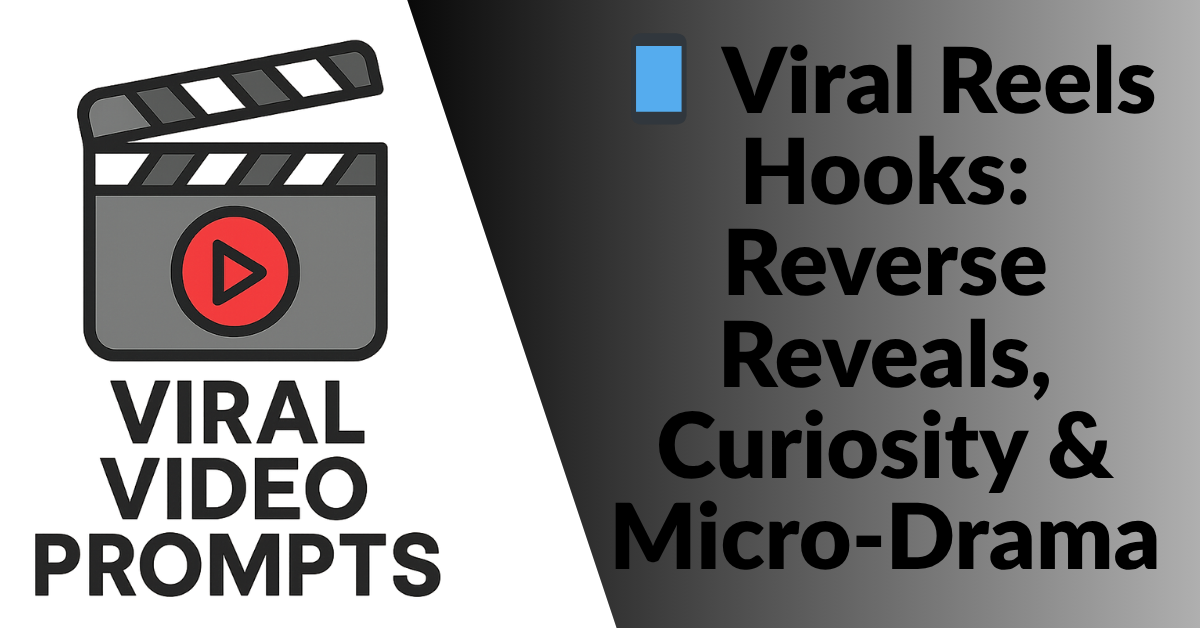
📱 Viral Reels Hooks: Reverse Reveals, Curiosity & Micro-Drama
-
by AiPrompt
- 78
If you’ve been binge-watching Reels lately, you’ll notice one thing: the most viral ones *don’t start at the beginning* — they start at the most dramatic, confusing, or visually intense moment. And then… they rewind.
This technique is called the **reverse reveal** — and when paired with curiosity triggers or micro-drama, it’s almost impossible to scroll past. Whether you’re sharing an AI art transformation, a storytime, a tool showcase, or even a productivity hack — this tactic gives your content **built-in tension**.
Micro-drama doesn’t mean fake storytelling — it means showing small stakes or personal moments that feel real and engaging. Think: “I almost quit,” “This nearly broke everything,” or “I messed up — and then this happened.” Add some curiosity, and you’ve got a **hook that works even with zero editing budget.**
Here are 5 viral-worthy prompt formulas that mix curiosity, reverse-reveal, and micro-drama to help your next Reel or Short blow up in 2025.
📱 Viral Reels Hooks: Reverse Reveals, Curiosity & Micro-Drama
Prompt: “Wait… how did we end up here?”
Start with a strange or chaotic scene → cut back to the beginning. Viewers stay to understand the story.
Prompt: “I wasn’t supposed to show this part, but here we go…”
Instant drama + forbidden vibe = curiosity spike. Great for AI fails, behind-the-scenes, or real moments.
Prompt: “Here’s what happened… but let me take you back.”
Classic reverse format. Reveal result → rewind to process. Works with AI outputs, fitness, design, coding, etc.
Prompt: “This wasn’t in the plan — but it changed everything.”
Unexpected event → emotional pull. Use this with a surprise AI result, client feedback, or breakthrough moment.
Prompt: “Before I explain, watch this 3-second clip.”
Curiosity bait + promise of context. Works well with time-lapses, transitions, or chaotic previews.
❓ FAQs
Q1: Do reverse reveals work for AI content?
A: Absolutely. Show the generated art/video/output first — *then* walk people through your prompt or method.
Q2: What is micro-drama exactly?
A: It’s the small moments of tension, surprise, or emotional shift. Something that makes the viewer *feel* there’s a story behind what they’re seeing.
Q3: Can I use this in educational content?
A: Yes — especially if you start with a surprising or “wrong” outcome. Reverse hooks help frame your video like a mystery to be solved.
Q4: How short should the hook be?
A: Aim to deliver the hook in 1.5 to 2 seconds. The goal is to stop the scroll before the viewer even decides what they’re watching.
Q5: What tools help with reverse edits?
A: CapCut, VN, and InShot make it easy to rearrange sequences + add captions to emphasize your dramatic moment.
🔥 Final Note:
Don’t overthink the drama. Start your video with the end, hint at something wild or emotional, and then just… rewind. That’s the formula creators are riding to millions of views right now.
Related posts:
If you’ve been binge-watching Reels lately, you’ll notice one thing: the most viral ones *don’t start at the beginning* — they start at the most dramatic, confusing, or visually intense moment. And then… they rewind. This technique is called the **reverse reveal** — and when paired with curiosity triggers or micro-drama, it’s almost impossible to…
If you’ve been binge-watching Reels lately, you’ll notice one thing: the most viral ones *don’t start at the beginning* — they start at the most dramatic, confusing, or visually intense moment. And then… they rewind. This technique is called the **reverse reveal** — and when paired with curiosity triggers or micro-drama, it’s almost impossible to…
